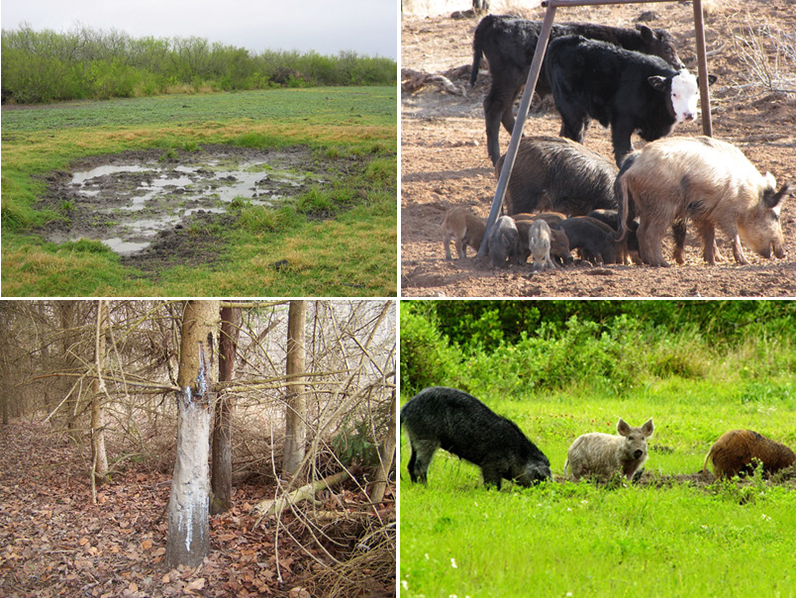Feral swine have recently invaded parts of the Northwest. They have been invading southwestern and central Oregon since 2004 and were first detected in Washington in 2016. Idaho has not seen significant numbers of feral swine, however migrating pigs may pose a threat. The population growth potential of feral swine is closely associated with food availability, which is becoming more abundant year-round due to warmer winter conditions that are linked to climate change.[1] Projected increases in extreme events and average summer temperatures in the region are not expected to negatively impact the success of feral pigs.[2] In response, timely population control measures are necessary to avoid damage to crops, forests, and rangelands.
 Damage caused by feral swine: soil disturbance , competition with cattle, tree damage, and digging up soil (upper left to right).
Damage caused by feral swine: soil disturbance , competition with cattle, tree damage, and digging up soil (upper left to right).Why are feral swine a problem? Feral swine are destructive to crops, pastures, and livestock, causing over two billion dollars in damages to US agriculture each year through a combination of:
- Eating crops and trampling or wallowing on cropland (damaging aggregate stability and organic matter)
- Damaging orchards and vineyards by digging in the soil (rooting), scratching, and marking territory
- Rooting pastures and damaging or killing desirable pasture species
- Harming livestock, especially lambs and calves, by spreading diseases and parasites
- Damaging irrigation lines, nets, trellises, and other infrastructure
Feral pigs are highly destructive to ecosystems as a whole by:
- Contaminating water supply
- Damaging soil organic matter and nutrient stability
- Spreading pathogens that can spread to humans
- Reducing diversity of trees by rooting and foraging in forests
- Displacing wildlife, such as deer and turkey, by depleting food sources
- Damaging native grassland plants, providing opportunities for establishment by invasive plants
- Damaging wild plants by eating and rooting
What can managers and landowners do to prevent further spread of feral swine in the Northwest?
[1]
Vetter, S. G., Puskas, Z., Bieber, C., & Ruf, T. (2020). How climate change and wildlife management affect population structure in wild boars. Scientific Reports, 10(1), 1-10.
[2] Dalton, M., and E. Fleishman, editors. 2021. Fifth Oregon Climate Assessment. Oregon Climate Change Research Institute, Oregon State University, Corvallis, Oregon.




